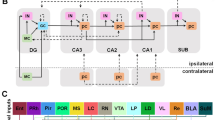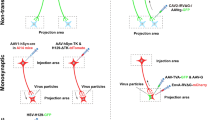Abstract
The paralemniscal area, situated between the pontine reticular formation and the lateral lemniscus in the pontomesencephalic tegmentum contains some tuberoinfundibular peptide of 39 residues (TIP39)-expressing neurons. In the present study, we measured a 4 times increase in the level of TIP39 mRNA in the paralemniscal area of lactating mothers as opposed to nulliparous females and mothers deprived of pups using real-time RT-PCR. In situ hybridization histochemistry and immunolabeling demonstrated that the induction of TIP39 in mothers takes place within the medial paralemniscal nucleus, a cytoarchitectonically distinct part of the paralemniscal area, and that the increase in TIP39 mRNA levels translates into elevated peptide levels in dams. The paralemniscal area has been implicated in maternal control as well as in pain perception. To establish the function of induced TIP39, we investigated the activation of TIP39 neurons in response to pup exposure as maternal, and formalin injection as noxious stimulus. Both stimuli elicited c-fos expression in the paralemniscal area. Subsequent double labeling demonstrated that 95% of neurons expressing Fos in response to pup exposure also contained TIP39 immunoreactivity and 91% of TIP39 neurons showed c-fos activation by pup exposure. In contrast, formalin-induced Fos does not co-localize with TIP39. Instead, most formalin-activated neurons are situated medial to the TIP39 cell group. Our data indicate that paralemniscal neurons may be involved in the processing of maternal and nociceptive information. However, two different groups of paralemniscal neurons participate in the two functions. In particular, TIP39 neurons may participate in the control of maternal functions.






Similar content being viewed by others
References
Andrezik JE, Beitz AJ (1985) The rat nervous system. In: Paxinos G (ed) Secondary reticular formation, central gray and related tegmental nuclei. Academic Press, New York, pp 1–28
Bajic D, Commons KG (2010) Visualizing acute pain–morphine interaction in descending monoamine nuclei with Fos. Brain Res 1306:29–38
Bajic D, Proudfit HK (1999) Projections of neurons in the periaqueductal gray to pontine and medullary catecholamine cell groups involved in the modulation of nociception. J Comp Neurol 405:359–379
Bajic D, Van Bockstaele EJ, Proudfit HK (2001) Ultrastructural analysis of ventrolateral periaqueductal gray projections to the A7 catecholamine cell group. Neuroscience 104:181–197
Bester H, Matsumoto N, Besson JM, Bernard JF (1997) Further evidence for the involvement of the spinoparabrachial pathway in nociceptive processes: a c-Fos study in the rat. J Comp Neurol 383:439–458
Bullitt E (1990) Expression of c-fos-like protein as a marker for neuronal activity following noxious stimulation in the rat. J Comp Neurol 296:517–530
Capone F, Aloisi AM (2004) Refinement of pain evaluation techniques. The formalin test. Ann Ist Super Sanita 40:223–229
Coolen LM, Veening JG, Wells AB, Shipley MT (2003) Afferent connections of the parvocellular subparafascicular thalamic nucleus in the rat: evidence for functional subdivisions. J Comp Neurol 463:132–156
Cservenak M, Bodnar I, Usdin TB, Palkovits M, Nagy GM, Dobolyi A (2010) Tuberoinfundibular peptide of 39 residues is activated during lactation and participates in the suckling-induced prolactin release in rat. Endocrinology 151:5830–5840
Dimitrov E, Usdin TB (2010) Tuberoinfundibular peptide of 39 residues modulates the mouse hypothalamic-pituitary-adrenal axis via paraventricular glutamatergic neurons. J Comp Neurol 518:4375–4394
Dimitrov EL, Petrus E, Usdin TB (2010) Tuberoinfundibular peptide of 39 residues (TIP39) signaling modulates acute and tonic nociception. Exp Neurol 226:68–83
Dobolyi A, Ueda H, Uchida H, Palkovits M, Usdin TB (2002) Anatomical and physiological evidence for involvement of tuberoinfundibular peptide of 39 residues in nociception. Proc Natl Acad Sci USA 99:1651–1656
Dobolyi A, Palkovits M, Bodnar I, Usdin TB (2003a) Neurons containing tuberoinfundibular peptide of 39 residues project to limbic, endocrine, auditory and spinal areas in rat. Neuroscience 122:1093–1105
Dobolyi A, Palkovits M, Usdin TB (2003b) Expression and distribution of tuberoinfundibular peptide of 39 residues in the rat central nervous system. J Comp Neurol 455:547–566
Dobolyi A, Wang J, Irwin S, Usdin TB (2006) Postnatal development and gender-dependent expression of TIP39 in the rat brain. J Comp Neurol 498:375–389
Dobolyi A, Palkovits M, Usdin TB (2010) The TIP39-PTH2 receptor system: unique peptidergic cell groups in the brainstem and their interactions with central regulatory mechanisms. Prog Neurobiol 90:29–59
Fenzl T, Schuller G (2002) Periaqueductal gray and the region of the paralemniscal area have different functions in the control of vocalization in the neotropical bat, Phyllostomus discolor. Eur J Neurosci 16:1974–1986
Fritschy JM, Grzanna R (1990) Demonstration of two separate descending noradrenergic pathways to the rat spinal cord: evidence for an intragriseal trajectory of locus coeruleus axons in the superficial layers of the dorsal horn. J Comp Neurol 291:553–582
Fuse G (1926) Vergleichend-anatomische Beobachtungen am Hirnstamme der Saugetiere. VIII.: Eine weitere Bemerkung über den Nucleus ventralis accessorius lemnisci lateralis bei einigen Karnivoren (Katze, Hund, Fuchs, Dachs, Meler anakuma). Arb Anat Inst Sendai 12:39–44
Hage SR, Jurgens U (2006) On the role of the pontine brainstem in vocal pattern generation: a telemetric single-unit recording study in the squirrel monkey. J Neurosci 26:7105–7115
Hannig S, Jurgens U (2006) Projections of the ventrolateral pontine vocalization area in the squirrel monkey. Exp Brain Res 169:92–105
Hardy SG, Haigler HJ, Leichnetz GR (1983) Paralemniscal reticular formation: response of cells to a noxious stimulus. Brain Res 267:217–223
Hashimoto H, Saito TR, Furudate S, Takahashi KW (2001) Prolactin levels and maternal behavior induced by ultrasonic vocalizations of the rat pup. Exp Anim 50:307–312
Haws CM, Williamson AM, Fields HL (1989) Putative nociceptive modulatory neurons in the dorsolateral pontomesencephalic reticular formation. Brain Res 483:272–282
Henkel CK, Edwards SB (1978) The superior colliculus control of pinna movements in the cat: possible anatomical connections. J Comp Neurol 182:763–776
Herbert H, Klepper A, Ostwald J (1997) Afferent and efferent connections of the ventrolateral tegmental area in the rat. Anat Embryol (Berl) 196:235–259
Herdegen T, Leah JD (1998) Inducible and constitutive transcription factors in the mammalian nervous system: control of gene expression by Jun, Fos and Krox, and CREB/ATF proteins. Brain Res Brain Res Rev 28:370–490
Hofer MA (1996) Multiple regulators of ultrasonic vocalization in the infant rat. Psychoneuroendocrinology 21:203–217
LaBuda CJ, Usdin TB (2004) Tuberoinfundibular peptide of 39 residues decreases pain-related affective behavior. Neuroreport 15:1779–1782
Lanteri-Minet M, Weil-Fugazza J, de Pommery J, Menetrey D (1994) Hindbrain structures involved in pain processing as revealed by the expression of c-Fos and other immediate early gene proteins. Neuroscience 58:287–298
Li C, Chen P, Smith MS (1999a) Identification of neuronal input to the arcuate nucleus (ARH) activated during lactation: implications in the activation of neuropeptide Y neurons. Brain Res 824:267–276
Li C, Chen P, Smith MS (1999b) Neural populations in the rat forebrain and brainstem activated by the suckling stimulus as demonstrated by cFos expression. Neuroscience 94:117–129
McIlmoyl M (1965) Two neurological staining techniques utilizing the dye Luxol fast blue. Can J Med Technol 27:118–123
Metzner W (1993) An audio–vocal interface in echolocating horseshoe bats. J Neurosci 13:1899–1915
Metzner W (1996) Anatomical basis for audio–vocal integration in echolocating horseshoe bats. J Comp Neurol 368:252–269
Min MY, Wu YW, Shih PY, Lu HW, Lin CC, Wu Y, Li MJ, Yang HW (2008) Physiological and morphological properties of, and effect of substance P on, neurons in the A7 catecholamine cell group in rats. Neuroscience 153:1020–1033
Morgan JI, Curran T (1991) Stimulus-transcription coupling in the nervous system: involvement of the inducible proto-oncogenes fos and jun. Annu Rev Neurosci 14:421–451
Pacak K, Palkovits M, Yadid G, Kvetnansky R, Kopin IJ, Goldstein DS (1998) Heterogeneous neurochemical responses to different stressors: a test of Selye’s doctrine of nonspecificity. Am J Physiol 275:R1247–R1255
Palkovits M, Baffi JS, Pacak K (1997) Stress-induced Fos-like immunoreactivity in the pons and the medulla oblongata of rats. Stress 1:155–168
Palkovits M, Dobolyi A, Helfferich F, Usdin TB (2004) Localization and chemical characterization of the audiogenic stress pathway. Ann N Y Acad Sci 1018:16–24
Palkovits M, Helfferich F, Dobolyi A, Usdin TB (2009) Acoustic stress activates tuberoinfundibular peptide of 39 residues neurons in the rat brain. Brain Struct Funct 214:15–23
Papez JW (1926) Reticulo-spinal tracts in the cat. Marchi method. J Comp Neurol 41:365–399
Paxinos G, Watson C (2005) The rat brain in stereotaxic coordinates. Academic Press, San Diego
Paxinos G, Watson C (2007) The rat brain in stereotaxic coordinates. Academic Press, San Diego
Pertovaara A (2006) Noradrenergic pain modulation. Prog Neurobiol 80:53–83
Russell JA, Douglas AJ, Ingram CD (2001) Brain preparations for maternity—adaptive changes in behavioral and neuroendocrine systems during pregnancy and lactation. An overview. Prog Brain Res 133:1–38
Sugimura Y, Murase T, Ishizaki S, Tachikawa K, Arima H, Miura Y, Usdin TB, Oiso Y (2003) Centrally administered tuberoinfundibular peptide of 39 residues inhibits arginine vasopressin release in conscious rats. Endocrinology 144:2791–2796
Terkel J, Damassa DA, Sawyer CH (1979) Ultrasonic cries from infant rats stimulate prolactin release in lactating mothers. Horm Behav 12:95–102
Usdin TB (2000) The PTH2 receptor and TIP39: a new peptide-receptor system. Trends Pharmacol Sci 21:128–130
Usdin TB, Hoare SR, Wang T, Mezey E, Kowalak JA (1999) TIP39: a new neuropeptide and PTH2-receptor agonist from hypothalamus. Nat Neurosci 2:941–943
Varga T, Palkovits M, Usdin TB, Dobolyi A (2008) The medial paralemniscal nucleus and its afferent neuronal connections in rat. J Comp Neurol 511:221–237
Ward HL, Small CJ, Murphy KG, Kennedy AR, Ghatei MA, Bloom SR (2001) The actions of tuberoinfundibular peptide on the hypothalamo-pituitary axes. Endocrinology 142:3451–3456
Zhao ZQ, Duggan AW (1988) Idazoxan blocks the action of noradrenaline but not spinal inhibition from electrical stimulation of the locus coeruleus and nucleus Kölliker-Fuse of the cat. Neuroscience 25:997–1005
Acknowledgments
Support was provided by the Bolyai Award of the Hungarian Academy of Sciences, the Hungarian Science Foundation NKTH-OTKA K67646, OTKA K100319, and OTKA NNF85612 research grants for AD, the Hungarian Science Foundation OTKA CK80180 research grant for MP, and the NIMH Intramural Research Program for TBU. We are grateful for the technical assistance of Szilvia Deák and Nikolett Hanák.
Author information
Authors and Affiliations
Corresponding author
Additional information
T. Varga and B. Mogyoródi contributed equally to this work.
Rights and permissions
About this article
Cite this article
Varga, T., Mogyoródi, B., Bagó, A.G. et al. Paralemniscal TIP39 is induced in rat dams and may participate in maternal functions. Brain Struct Funct 217, 323–335 (2012). https://doi.org/10.1007/s00429-011-0357-2
Received:
Accepted:
Published:
Issue Date:
DOI: https://doi.org/10.1007/s00429-011-0357-2




